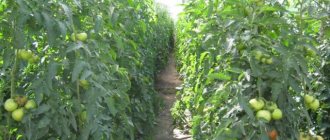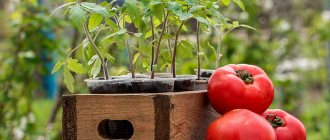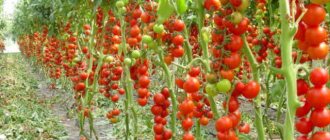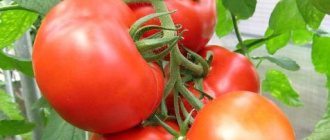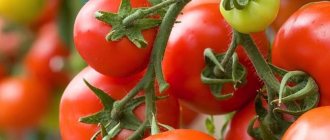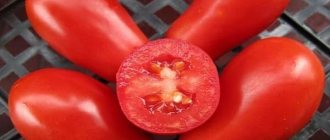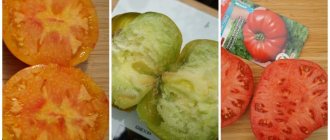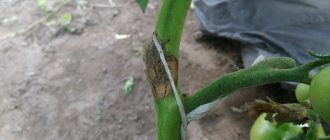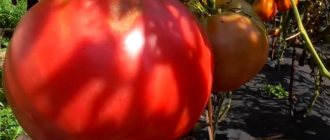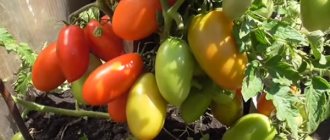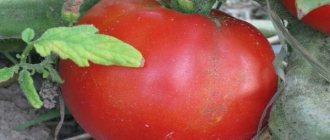Vegetable growing » Tomatoes
0
1879
Article rating
Kira Stoletova
Tomatoes are considered one of the most popular vegetable crops. To get a high-quality and large harvest of tomatoes, you need to choose the right variety for certain growing conditions and carefully care for the seedlings. What is the yield of tomato from one bush, depending on the species characteristics of the vegetable? Is it possible to increase the indicator in this area without harming the fruits?
Indicators of tomato yield per bush
How to properly grow tomatoes in open ground: preparing beds
It is not always possible to grow tomatoes in the ground according to our grandmothers’ recipes. Times, conditions, ecology have changed, new diseases have appeared, pests have been added. Take up the literature, read carefully the recommendations on how to properly grow tomatoes in open ground, study your zone and the predecessors for this crop. Varieties should be chosen mainly zoned.
Start by preparing the soil, which must be dug up in the fall and left for the winter without breaking up the lumps.
Predecessors can be all crops except nightshades (tomatoes, peppers, eggplants, potatoes), as well as strawberries, but it is better to plant after garlic, cucumbers, early cabbage, and legumes. And we return the tomatoes to their original place no earlier than after 2-3 years.
Prepare beds for tomatoes 2 weeks before planting seedlings, dig to a depth of 25-30 cm, level with a rake, spray with a 1% solution of Bordeaux mixture on dry soil. If it is not possible to spray, then pour a warm solution (up to 50 °C) of potassium permanganate.
To grow a good harvest in open ground, before planting in trenches or holes, add well-rotted compost or manure at the rate of 2 kg per hole, then on the day of planting - 50 g of superphosphate and 20-30 g of potassium sulfate, and potassium sulfate can be replaced with 2 cups of wood ash. Fertilizers are applied to holes or trenches one at a time and mixed thoroughly.
This video of growing tomatoes in open ground shows how the beds are prepared:
Features of tomato care
To get an excellent harvest you need to work hard. Despite the fact that varieties intended for open ground are more viable and resistant to the vagaries of weather, plants need regular watering, fertilizing, formation of lashes and garter.
Watering tomatoes
Growing tomatoes in open ground begins with an irrigation system. As a rule, it is enough to moisten the bed once every 7 days. If you do this irregularly, the skin of the fruit will crack. During each procedure, the soil must be moistened to a depth of 35 cm. For irrigation, water heated in a barrel to ambient temperature is used. Water the plants at the roots or between the rows, but without irrigating the foliage. To do this, it is more convenient to use a watering can with a “spout” or a ladle with a long handle.
After planting, it is better to immediately mulch the soil, covering it with straw, peat or humus. This will not only retard the growth of weeds, but will also maintain a certain temperature regime. If there is no mulch layer, then the beds must be loosened and weeded; for successful development, the root system needs good aeration.
Pinching and pinching tomatoes
When growing tomatoes in open ground, the bushes are short, but, nevertheless, they also need pinching and pinching. Bushes are formed into one, two or three stems. The first 2 methods are most often used. In the first case, all the stepsons are removed; when grown in two stems, a single shoot is left under the first raceme of the inflorescence, and the rest are mercilessly removed. The shoots are pinched off or cut off carefully, leaving a “stump” of 1 cm; it is better to use a sharp knife so as not to injure the plant too much.
At the beginning of August, the plant is pinched, removing the top after 3 clusters of inflorescences are formed. All unset inflorescences are promptly removed; this procedure accelerates the growth and ripening of fruits. By the end of the season, the lower leaves are also removed, but not all at once, but in stages.
Fertilizer application
During the season, the farmer must carry out several feedings. When carrying out the procedure, you can adhere to the following scheme.
- The first feeding is carried out 12–14 days after planting the seedlings in the garden bed. 5–7 g of superphosphate and 3 g of ammonium nitrate are diluted in 5 liters of water. Consumption: 12–14 liters per 1 m² of planting.
- The second feeding is carried out with the appearance of the first ovaries. 6–7 g of potassium sulfate and 3 g of ammonium nitrate are diluted in 5 liters of water. You can alternate with organic fertilizers using a solution of mullein (the optimal ratio is 1:10) and poultry (chicken) droppings (the concentration is 2 times lower - 1:20).
When growing tomatoes in open ground, special attention should be paid to applying fertilizers. If it is not possible to purchase highly concentrated substances, then the solution is prepared based on liquid complex fertilizers
Tall plants are tied to a support; to do this, a wooden peg is driven in near the bush and the stem is secured with twine. Small bushes do not need this procedure. The ripening of the first tomatoes begins after July 10, provided that the early ripening variety was chosen. Varieties with an average ripening period begin to bear fruit in early August. Harvesting should not be delayed, as there is always a risk of tomatoes being damaged by late blight. If weather conditions are expected to worsen, then half-ripe fruits can be collected and left to ripen on a sunny windowsill.
How to increase tomato yield by regulating development
Any variety or hybrid initially has a tendency towards one or another type of development, so it is necessary to correct the development of plants in time, starting from the stage of growing seedlings. Tomatoes can be divided into two groups according to the type of growth and development - with a vegetative and generative type of development. This division is rather conditional than unambiguous, since the type of plant development can be controlled and, if necessary, shifted in one direction or another.
When growing several varieties and hybrids at the same time, it is necessary to find an “approach” to each individually. And maintain this “optimal balance” throughout the season. This is the only way to obtain high yields of good quality fruit and realize all the best that is inherent in a given variety or hybrid. This can be done in various ways, depending on the specific situation.
Tomatoes with excessive vegetative development. In appearance, such a plant can be called “fatifying”. It has a powerful, thick stem with long, dark green leaves. The crown often has curled leaves that do not straighten with age. Such plants grow faster than others. The stepchildren are highly developed. The inflorescence is longer than usual, often ending at the end with a leaf or shoot, maybe even branched, with a large number of flowers. But on one inflorescence 1-2 flowers bloom at the same time, the set fruits fill slowly, are of unequal size and have many underdeveloped fruits, especially at the ends of the racemes. The flowers are light yellow in color, and several clusters can bloom at the same time. The stem tissues are “unripe”, tender, and such plants are often affected by diseases and pests. The upper inflorescence is located far from the crown, more than 15 cm. The inflorescences extend from the shoot at an acute angle. In such plants, “all efforts” are devoted to the development of roots and green mass, so the yield is extremely low.
Tomatoes with excessively generative development. Such plants, on the contrary, can be relatively tall, but with compact leaf apparatus. Subsequently, with increasing fruit load, the plant greatly slows down or completely stops vegetative development. The leaves are short, dark green, the crown of the plant is thin (thinner than 1 cm in indeterminate tomatoes), the raceme is simple, short, with several bright yellow flowers blooming simultaneously. The fruits in the cluster are the same size and set well. The upper raceme is located almost at the very top of the plant, less than 15 cm from it. The inflorescences do not extend from the shoot at an acute angle, but are strongly bent downwards. There are fewer flowers in the inflorescence than usual, although the clusters continue to bloom and set fruit. One inflorescence blooms on a plant at a time. The stepchildren are weak or stop developing altogether. In such plants, “all efforts” are devoted to the development of fruits, but to the detriment of the development of the leaf apparatus and root system, which will also affect the overall yield.
Both of these extremes guarantee a low yield, so one or another type of plant development should not be allowed to predominate. More precisely, it is important to be able to correctly adjust agricultural technology and timely redirect the development of the plant in one direction or another.
Initially, it is important to take into account the characteristics of the variety or hybrid itself. Leading seed manufacturing companies always indicate on the packaging briefly the main characteristics or any individual characteristics of a given variety or hybrid. But this is only preliminary, so-called “starting” information.
In practice, it is necessary to take into account the characteristics of a particular area and its weather conditions. And this is not easy, since the weather is not the same every year and the same variety (hybrid) can behave differently. For example, in cool, rainy summers, determinate tomatoes may behave like semi-determinate tomatoes.
In summer cottages, greenhouses, as a rule, are not heated and are not equipped with additional equipment that would allow maintaining optimal conditions for plants. Therefore, in order not to be left without a harvest, it is advisable to simultaneously grow several varieties and hybrids with different characteristics. For an early harvest, varieties (hybrids) that are capable of setting fruit well in unstable May weather are important. At the height of the summer season, varieties (hybrids) that tolerate heat well will come to the rescue.
At the beginning of the growing season (seedling stage), it is important to obtain plants with a well-developed leaf apparatus and root system at the time of planting in a permanent place.
For low country greenhouses, with a ridge height of 2.0-2.5 m, lovers of tall tomatoes are better off selecting varieties (hybrids) with shortened internodes and forming them into two stems. Once the plants reach the trellis wire, there will be an average of 3 clusters on each shoot. Additional shoots should be released during the seedling period under the first cluster.
As a rule, tall, large-fruited tomatoes are prone to exhibiting a vegetative type of growth. It is advisable to plant seedlings of varieties (hybrids) with a vegetative type of growth in a greenhouse with the first and second clusters already blooming. Otherwise, it will be very difficult to eliminate fattening of plants.
It is advisable to carry out all agrotechnical measures to regulate the development of plants in one direction or another only when the plants receive balanced mineral nutrition. It is also worth monitoring the fruit load of plants and adjusting it in time, based on the prevailing weather conditions and the characteristics of the variety or hybrid itself. Limit nitrogen until the fruits form on the first cluster, especially in varieties (hybrids) with a vegetative type of development. Then, throughout the entire growing season, apply a sufficient amount of phosphorus-potassium fertilizers. During the period of flowering and fruit set, the tomato experiences an increased need for phosphorus fertilizers, and during fruit growth - for nitrogen and potassium fertilizers.
A week before planting in the ground, it is better to stop feeding the seedlings. After planting in the greenhouse, the first fertilizing should be done after 12-14 days. In case of an excessively vegetative type of development, you can give foliar fertilizing to the leaf with an extract of superphosphate and root fertilizing with phosphorus-potassium fertilizers. With an overly generative type of development, it is good to give 1-2 fertilizing with a solution of fermented weeds without adding phosphorus-potassium fertilizers. In the case when the plants are loaded with fruits and the weather is cool, this can aggravate the situation, since it will delay the ripening period of the fruits.
Soil preparation
If you are going to plant medium-fruited varieties, then make sure that the soil is warm; this is not just a whim of care, but a necessity. Don't plant tomatoes where potatoes grew, otherwise the tomatoes are almost guaranteed to get late blight. Also, you shouldn’t plant them where there used to be eggplants and peppers. In this way you will simply destroy the crop. It is best if carrots, cucumbers and onions grow in front of the tomatoes. And if you decide to plant tomato and strawberry seedlings side by side, the fruits of both plants will become larger, and the harvest itself will increase a couple of times.
Also, tomatoes do not like acidic soil, so choose those areas in the open ground where compost, ash and lime were previously added. To understand the acidity level of exposed soil, purchase a simple pH test. The lower it is, the greater the acidity. We evaluate the amount of nutrients. Micronutrient analysis can be done in the laboratory. It is inexpensive, but very important, since the yield this year depends on it.
Nitrogen has a great effect on the leaves. If there is not enough of it, the tomato will have limp and yellowed leaves. To ensure that the soil can receive nitrogen, add flour, compost, or inorganic nitrates to the soil.
Potassium gives tomatoes their strength. It resists diseases. If there is not enough of it, the seedlings will grow poorly and look very stunted. To “give” the soil potassium, supplement the soil with sand, granite dust or wood ash.
Phosphorus. Strengthens roots and regulates seed formation. If it is not enough, then the tomatoes will have bad, tasteless and unripe fruits. To increase phosphorus levels, add superphosphates, compost and bone meal to the soil.
Compost is an excellent soil preparation tool. It will attract earthworms, and they will loosen the soil and create conditions for the appearance of beneficial bacteria. It is necessary to prepare open ground for growing tomato seedlings in the fall, after cleaning the area. You should also dig up the ground several times and harrow it. Tomato seedlings love humus, but they absolutely “hate” manure, because because of it they begin to grow tops. 12 days before planting, we form ridges in the north-south direction.
Square nest planting
This method simplifies subsequent procedures for caring for bushes; by choosing it, you can create optimal and favorable conditions for the formation and development of plants that will absorb maximum oxygen and sunlight.
Read here - Black leg in tomatoes: diseases and tips on what to do and how to cure tomatoes. 110 photos and video instructions for treatment
The optimal level of illumination and ventilation of plants can increase the yield of different varieties due to increased absorption of nutrients and excellent conditions for the growing season, which has a beneficial effect on the flowering process and fruit formation.
Formation of tomato bushes
First, don’t forget to help your tomato plants develop correctly - the technology for growing almost all varieties and hybrids of tomatoes includes this point, regardless of the weather.
Among the tomatoes that do not require pinching, we can mention such varieties as Zhemchuzhinka, Krasa Gridki, Kremlevsky, Little Prince, Gardener's Dream, Pygmy, Polarnik, Sweet Girl, Ranetochka and hybrids Anyuta F1, Mikhey F1, Severenok F1, Semko 2006 F1.
Tomato pinching - the process of removing all the extra side shoots that grow from the axils of the leaves - helps to form a beautiful plant and leave it more strength to form fruits.
Depending on the plant variety, a tomato bush is formed into one or two or three stems. All other shoots (no more than 3-5 cm long), growing in the axils of the leaves on both the main and lateral branches, are carefully broken off with your fingers every 7-10 days. This procedure contributes to the ripening of the crop 12-20 days earlier than without pinching.
How to root tomatoes correctly and is it necessary to do it at all? Why shoot tomatoes, how to do it correctly and what will happen to the tomatoes if you don’t do this? Let's figure it out together!
It is also very important to promptly remove excess green leaf mass from tomatoes, which takes away nutrition from the future harvest. First of all, the lower leaves are torn off, especially those in contact with the soil - this will help improve air exchange in the lower part of the tomato plant (this is especially important in dry or, conversely, excessively wet weather), prevent the appearance and spread of late blight, and accelerate the ripening of fruits
They begin to do this a month after planting the plants in the ground, removing 1-3 leaves per week (leaving a small stump) in warm, dry weather without active sun. On the stem below the first inflorescence, by the time the fruit ripens, there should be no leaves on it at all. Then they continue to be removed, but not more than 2-3 inflorescences.
Secret No. 10. Stepsoning
In order for the plant to spend energy on the formation of fruits, and not new greenery, it is necessary to periodically remove its side shoots-stepchildren.
When cutting a shoot, you should leave a small shoot - such a “wound” will heal faster, and a new branch will not grow in its place.
Some varieties of tomatoes can reach three meters in height.
Everyone can increase their tomato yield. It is enough to choose a good variety and follow simple rules.
Bush formation
It is necessary to form a tomato bush in time, otherwise the plant will give all its strength and nutrients to the lower leaves, stepsons and unnecessary branches. In contact with the ground, the lower leaves become a conductor for infections. Experienced summer residents advise cutting off 1-3 lower leaves, starting in June, every week until the first inflorescence. This will ensure good ventilation and remove excess stress from the leaves.
Foliage is removed in dry, warm weather, preferably in the morning. The wound should have time to heal without becoming an entry point for bacteria and fungi. The summer resident should determine how many leaves to remove from the bush based on the inflorescences and fruits. Until all the fruits are set on the brush, on top, that is, above the brush, all the leaves should be present. How to properly form a bush, look at this picture.
Harvesting tomatoes
In the middle zone, ground tomatoes ripen in late July - early August. To avoid damage, the fruits are removed very carefully: take them in your hand and pinch off the stem with your thumbnail.
If the summer is not very hot and the tomatoes don’t want to turn red, you can “hurry them up”:
- the bushes can be watered with a pink solution of potassium permanganate (the tomatoes on them will turn red about a week after the procedure);
- the bushes can also be generously sprayed with iodine solution (30-40 drops per 10 liters of water);
- the bases of the bushes can be tightly wound with copper wire (on such plants the fruits will begin to turn red 10 days earlier than on others);
- using a disposable syringe, 0.5 ml of vodka or 0.25 ml of alcohol can be injected into each fetus (it is advisable to do 2 injections on opposite sides)
Tomatoes that have not had time to ripen on the bush (brown and milky in color) are carefully removed and placed in several layers in boxes, covering each layer with paper. At the same time, be sure to put several ripe red tomatoes there: they will speed up the ripening of neighboring fruits.
When the night temperature drops to 10°C, the remaining crop is harvested. Green tomatoes are used for processing and pickling, and the rest are dipped in water at a temperature of 60°C for 1-2 minutes, then dried, placed in boxes and stored in a well-ventilated area with a humidity level of 80-85%. It is desirable that the air temperature be within 16-18°C. Then the tomatoes will ripen in 2-3 weeks. At a lower temperature (about 10°C), the fruits will ripen in about 1.5 months. Remember to periodically check the contents of the boxes to pick up ripe fruits and throw away rotten ones.
The best tomatoes for open ground: what qualities they should have
The best varieties of tomatoes for open ground are considered to be low-growing varieties. The bushes, small in height, produce many strong shoots strewn with fruits. Medium-sized varieties are used somewhat less frequently for greenhouse-free cultivation. The size of plants of this type requires not only staking, which is undoubtedly more convenient to do in a greenhouse, but also a large amount of heat, which can be fully provided by a specially designed greenhouse.
Please note: Vegetables in open ground are always in more difficult conditions than in greenhouses. That is why their choice should be made, giving preference to more hardy varieties. In the case of tomatoes, the most suitable for open ground are low-growing, early-ripening, super-determinate varieties.
Low-growing tomatoes for open ground have characteristics that distinguish them from greenhouse varieties. Among them, especially noteworthy:
- Resistant to temperature changes. Early tomatoes for open ground can be exposed not only to extreme heat, but also to spring frosts, from which not a single gardener living in central Russia is immune. That is why, as a result of long-term agricultural work, the best varieties of tomatoes were developed that are not afraid not only of cold weather, but also of light frosts.
- Standard growth. Such germination of low-growing varieties of tomatoes for open ground is an undoubted advantage, which greatly facilitates their care. We are talking, first of all, about the absence of the need for stepsoning.
- Friendly return of the harvest. This characteristic can also be considered an advantage. The uniform ripening of fruits eliminates the need for ripening. This means that tomatoes collected from these bushes can be used simultaneously in large quantities, for example, for homemade preparations, drying, freezing, and so on.
- Short growing season. Tomato varieties for open ground were bred by breeders taking into account the fact that plants outside the greenhouse must produce a harvest in the shortest possible time. Greenhouse tomatoes ripen on average 15-25 days later. We are talking about mid-season and late varieties. This is why they are more susceptible to late blight, which is a cold weather disease that occurs in mid-summer.
Choosing a site for growing tomatoes and preparing the soil
The bed should be laid out in a well-lit place, the soil should be closer to neutral and rich in nutrients. Too heavy soil is diluted with peat or sawdust. It is better to place the plantings on the south side of the site and in such a way that the plants are not blown by cold winds. Often, gardeners make single-row beds along fences or outbuildings.
Every 3, or better yet 2 years, the planting site should be changed. Pathogens of various diseases remain in the soil, affecting both tomatoes and other nightshades. Therefore, when growing tomatoes in open ground, the best predecessors for them are: onions, carrots, garlic, zucchini, squash, pumpkin, and all types of cabbage. Do not plant after peppers, potatoes, and eggplants.
The beds for digging have been prepared since the fall. Manure or other organic fertilizers are added to the soil. If bed preparation begins in early spring, then manure cannot be used; it is replaced with humus or compost. You can also add minerals to the soil; per 1 m² you will need the following amount:
- superphosphate – 80 g,
- potassium chloride – 20 g.
You should not apply too much fertilizer “in reserve”; this will cause active growth of green mass, but will negatively affect fruit set.
How to grow a good crop of tomatoes in open ground: proper watering
Care when growing tomatoes in open ground must be careful; we must not forget that this crop loves dry air and moist soil; it is impossible to loosen the rows after each watering, but mulching is very desirable.
Splashes of water should not fall on leaves and fruits. It is better to water tomatoes in the first half of the day, but you should not let them wilt. The water temperature in warm and hot weather should be moderately warm, but not lower than 20-25 °C. For proper watering in cold weather, the water must be heated to 25-30 °C.
As long as the soil is well moistened, tomatoes when grown in open ground are not afraid of overheating; the rate of water evaporation by the leaves increases, and they cool. Therefore, tomatoes can grow and bear fruit well even at temperatures of 32-35 °C. If there is not enough moisture or watering is uneven, that is, from time to time, then the rate of water evaporation by the leaves drops, and the tomatoes overheat already at a temperature of 30 ° C. In this case, the tomato pollen turns out to be sterile, and the plants shed buds and flowers.
Growing tomatoes in open ground using drip irrigation allows you to solve several problems at once:
- timely supply of water to the root zone;
- supply of complete mineral fertilizer in strictly verified standards;
- reducing the spread of fungal plant diseases;
- improving the quality and quantity of the harvest, increasing the keeping quality and transportability of fruits.
The most common mistakes in caring for tomatoes when growing in open ground are the following:
- Dry soil and high temperatures lead to shedding of flowers and small ovaries.
- Dry soil does not allow plants to fully absorb nutrients and causes a deficiency of boron and other microelements.
- During the period of fruit filling under conditions of overfeeding with nitrogen-containing fertilizers, dry soil causes blossom end rot of tomatoes.
- Irregular watering leads to cracking of the fruit.
- Late watering (towards the end of the day) increases humidity, and flowers are poorly pollinated. The leaves become moisturized at night, and if your tomatoes are covered with film, then cold drops of condensation contribute to the development of fungal diseases.
To grow a tomato crop in the soil as abundant as possible, do not water the plants with cold water, especially in hot weather: this leads to shock, severe stress on the roots, promotes the spread of bacterial diseases, depresses the plants, and prevents them from absorbing essential trace elements and phosphorus. As a result, fruiting is delayed and reduced.
Proper watering when growing tomatoes in open ground is demonstrated in this video:
How to water tomatoes in open ground
A good harvest of tomatoes in open ground is impossible without proper watering.
The intensity of watering is selected depending on the reaction of the plants (if the leaves droop, then the time has come). Tomatoes in open ground should be watered only at the root (no sprinkling!), with water heated in the sun and in such a way that water does not get on the leaves. An excellent choice for these purposes is a drip irrigation system, which will save you water and reduce the risk of fungal diseases. This system can be purchased at a store, or you can make it yourself. After watering, the soil between the rows is loosened and weeds are removed.
How often do you need to water tomatoes in open ground? Summer residents who are accustomed to visiting their plot only on weekends are worried. It all depends on weather conditions - both excessive and insufficient moisture are harmful to these plants.
The norm for watering tomatoes in a typical average Russian summer looks like this:
- Tomatoes are watered for the first time 2-3 weeks after planting in open ground;
- in the first half of summer, plants are watered rarely, but abundantly: 1-2 times every 10 days, while 3-4 liters of water are consumed per plant;
- during the formation of ovaries, the watering rate is increased by 2 times and the plants are watered every 2-3 days (do this in 2-3 doses so that the soil is better saturated with moisture);
- When the tomatoes begin to ripen, stop watering.
If the temperature in summer is higher than usual, then you will have to water the plants more often (every 2-4 days). Alas, in the midst of a drought, simply pouring twice the volume of water on the tomatoes once a week will not work - after the soil has become very dry, you cannot immediately water heavily - the fruits may fall off, crack, or develop blossom end rot. The watering rate in this case is 0.8-1 liters per plant at a time.
How to properly water tomatoes in a greenhouse and open ground We will tell you how to water tomatoes and how to properly combine watering with fertilizing.
Suitable varieties for open ground
Determinate and indeterminate varieties are planted in open ground.
Determinant
Tomato bushes are low and compact, with large fruits. Such specimens do not need supports and require minimal shaping. They ripen quickly and together. Suitable for strips with short summers.
Determinate varieties of tomatoes
Here are some of them:
- Rio Grande (Dutch selection). The bushes reach 50–60 cm. The fruits are medium-sized elastic cream. Well stored and preserved.
- Summer resident. The height of the bushes is about half a meter. An unpretentious, high-yielding tomato that adapts well to low temperatures.
- Roma. Standard bushes that do not require garter. Medium ripe, high quality tomatoes. Grown in open ground for canning.
- Crimson giant. The name refers to the color and size of the fruit. Early variety. The bushes are low (70 cm). Productivity is good.
- Danko. A variety with large and tasty fruits. The bush itself is 50 cm, but due to the heaviness of the fruit it needs to be strengthened with supports. The variety copes well with drought and has an average yield. Does not tolerate transportation over long distances.
Other determinate tomatoes also ripen successfully in open ground.
Crimson Giant
Indeterminate
Although these tomatoes are recommended to be cultivated in greenhouses and greenhouses, open ground is also suitable for cultivation. Plants stretch up to 2.5 meters, so they need supports or a garter. There are large-fruited varieties, but many varieties are cherry varieties.
- Of the tall varieties, the most common tomatoes are Bull's Heart, De Barao, Red Red.
- Following them, the tomatoes Batyanya, Tolstoy, Koenigsberg, Budenovka, which are less demanding and high-yielding, are popular among gardeners.
Even in a small plot, 6-8 varieties of tomatoes are grown simultaneously. If the ripening time varies, fresh tomatoes are eaten throughout the season. But the most important thing is that the tomatoes are suitable for a particular region.
Growing tomatoes
Secrets for growing tomatoes
Those who have been growing vegetables for many years accumulate observations, tricks, and secrets. Here are some of them. Although tomatoes are quite unassuming, if you neglect them and allow late blight to take over them, your pets will die in a couple of days.
First of all, you need to make sure that the seedlings are strong, strong and healthy.
When growing in open ground, and not in a greenhouse, the plant must be covered with spunbond, but when the ambient temperature drops, it is replaced with polyethylene, and when it warms up, it is changed back.
It must be said that until the tomato seedlings have reached their optimal stage of development (the formation of a bud on the first flower cluster), they cannot be planted in open ground. But it is also not recommended to delay this, since under-ripening and over-ripening of seedlings will negatively affect the quality of the harvest. It turns out that seedlings intended for a greenhouse need to start growing earlier than those for open ground. Approximate dates will be developed in practice through trial and error, but for the Moscow region and neighboring regions this is the first quarter of March for greenhouses and the last quarter of March for open ground, but taking into account the characteristics of the variety.
Seedlings that have been in boxes for too long can stretch out, and in this case the upper parts of the plants, 20-25 cm long, can be torn off and placed in some container. After a couple of days, roots will begin to appear on the torn part and then it makes sense to replant it in the soil. There will be no negative effect from such procedures. Accordingly, the same can be done with the part of the plant that broke off during planting. The plant will grow just like the rest.
It is forbidden to plant tomatoes densely. The distance from one plant to another should be 60 cm or more. If there is a shortage of land next to the tomatoes, you can plant leeks. These two plants successfully coexist with each other.
As the tomatoes grow, their leaves will come into contact and this should not be allowed - the leaves are cut off. Those that are leaning towards the ground are also plucked. Do not hesitate with pinching and eliminating shoots growing from the root. Each leaf on the plant should be blown freely - this reduces the likelihood of late blight.
When planting tomatoes, it is recommended to deepen them so that the stem grows additional roots.
Tomatoes like potassium permanganate, so it is advisable to constantly water them with a bright pink solution, from which the fruits acquire a sweetish taste and increase their ability to resist disease. But once the plants begin to mature, you can stop watering them unless the weather is dry.
Tomatoes do not take much organic fertilizers; it is better to apply mineral fertilizers with microelements.
To avoid excessive use of chemicals against late blight, the plant must be constantly monitored. At the first symptoms of the disease, appropriate medications are used, but not in rainy weather.
Also, the risk of disease is greater if potatoes grow near tomatoes, which are directly involved in the spread of late blight.
❧ The productivity of tomatoes can be increased if, during the appearance of buds, flowering, and fruit set, you water them at intervals of 9~12 days, and during fruit ripening - at intervals of 15-20 days.
It has been experimentally revealed that low varieties of tomatoes are much worse than plants of medium and high growth. The fact is that the latter are less susceptible to diseases, have increased productivity, and are simply tastier. Although they are a little more difficult to care for, it pays off handsomely. You should not forget to tie them up, as due to their height they tend to fall over.
Without waiting for the immediate arrival of frost, it is recommended to uproot tall varieties of plants with fairly small fruits and hang them in some room with their roots up - for about a month these bushes will still be useful in the form of a tomato harvest.
It is best to compost dead plants, their parts, and any organic debris. However, it would be advisable to burn a plant that has suffered from a dangerous infection, and do it correctly: the tops are pulled out, dried away from living plants, and then burned on some object raised above the ground, for example, on a metal sheet laid on bricks. In this case, the surface of the earth will not burn out. After this procedure, the ashes can be collected and used as fertilizer for any plants, with the exception of nightshades.
how to grow a good tomato crop. planting, pinching, fog treatment, etc.
Tatiana Tsivilskaya
Read this... Interesting. . Experience of Olga Nikanorova 1. Tomatoes were grown using the technology of growing tomato trees, with the exception of the system for supplying plant roots with oxygen, since the process turned out to be too labor-intensive. The plants were planted in plastic bags (there were no barrels). I glued the bags myself from the thickest film with a thickness of 200 microns. The result was a package 1.5 meters long and 0.9 meters wide without a bottom. 4 stakes were driven into the ground and a pipe bag was put on them. I folded the package slightly from the bottom and pressed the edges with bricks. The stakes are needed to prevent the package from falling on its side under the weight of the soil. The upper long part of the package served as a greenhouse-dome in May (it was tied into a bun with a rope). After the threat of frost has passed, the bag can be lowered and wrapped. Tomatoes bear fruit from late June to late October. The early production of tomatoes is due to the fact that the seedlings were planted at the usual time, and with the use of EM technology they developed more intensively. To extend the fruiting period in October, the tomato trees were covered with film or lutrasil. The tomato tree develops several powerful trunks that have strong leaves. There are too many leaves and the bush is not ventilated. To avoid the disease of tomatoes with Phytophthora, all leaves from which the shoots have appeared are removed. And once a week, tomatoes are sprayed with Baikal solution (without adding a nutrient medium). As a result, crop losses were avoided at a time when neighbors in the country and many acquaintances were complaining about the loss of most of the crop from late blight. Every year I look for new varieties of tomatoes suitable for growing using this method. “Sprut” performed well. Tomatoes from two trees were eaten and stocked for two families. The tomatoes are all even, each weighing exactly 100g. The taste is normal and is excellent for preservation. This year, the “Wild Rose” and “Oxheart” varieties gave amazing results! The fruits were up to 950 grams instead of the promised 400, extraordinary taste, without veins and green spots. “The Yellow Giant” also pleased me! But the “Goldfish” and “Red Icicle” varieties produce good fruits, but have limited growth and do not use all the nutrients that EM compost gives them. Hybrid varieties grow well, but as a rule have limited growth (except for "Octopus"). I had high hopes for the “Mazarin” variety, bought the seeds very expensively... but the variety did not justify itself! This year, only four of the tomato trees produced fruit at full capacity. and this was enough for food, for preparation and for sale on the market. Moreover, on the market, the products grown using EM technology looked different from the rest and were bought with pleasure at the maximum price. This year I planted 3 tomatoes using this technology..
Evgenia Taratutina
To grow a good tomato crop, you need to do everything on time. Plant, water. pass. tie up
- How to grow tomatoes in a greenhouse in winter
- How to grow a tomato on the balcony
- How to grow tomatoes on the balcony in summer
- How to grow a large harvest of tomatoes in a greenhouse
- To grow a good tomato crop in a greenhouse
- Grow tomatoes without seedlings
- How to get a good tomato harvest in a greenhouse
- How to grow tomatoes in open ground
- How to grow tomatoes on the balcony video
- What type of tomato to grow on the balcony
- How to grow tomato seeds
- How to grow tomatoes in a greenhouse
- Grow tomato seedlings
- Grow tomato seedlings
- How to grow tomato seedlings video
- How to properly grow tomatoes in greenhouses
Caring for seedlings before transplanting into the ground
Watering, fertilizing, observing light and thermal conditions - all this forms the basis for caring for seedlings after picking.
Watering seedlings
The flow of water passes through all organs of the plant, ensuring the transport of nutrients from the soil. Having distributed the food, the water almost completely evaporates, and the nutrients, on the contrary, are retained and, thanks to metabolism, are converted into plant tissue.
It is difficult to give clear advice on how often to water tomato seedlings. This depends on the volume of the container, temperature and humidity, as well as the age of the plant and its size. For example, seedlings are watered about once a week, but just before planting, the seedlings require almost daily watering.
Do not allow the soil to dry out, otherwise the plants will begin to wither. Watering should be plentiful so that the earthen ball is completely moistened. However, excess water can also be harmful. When the soil is constantly waterlogged, oxygen access becomes difficult and roots develop poorly. In addition, such conditions for keeping tomato seedlings often lead to diseases. Therefore, carry out each subsequent watering after the top layer of soil has dried.
Water for irrigation should be warm, approximately 22°C. Tap water should be left to stand for at least 24 hours.
Feeding
For normal growth and development, tomato seedlings need to be provided with proper nutrition. The list of useful elements amounts to several dozen, but the most important are nitrogen, phosphorus and potassium. Their deficiency can lead to the most serious consequences for plants.
The first root feeding with solutions of mineral fertilizers is carried out 10-15 days after picking. The second - 10-15 days after the first.
For feeding, it is best to use ready-made complex fertilizers designed specifically for seedlings. The packaging must indicate the composition, as well as detailed dosage. At the same time, complex fertilizers can be used not only for root, but also for foliar feeding (for example, spraying).
Hardening of seedlings
At home, it is easy to monitor the temperature and light levels of seedlings. But after planting in a permanent place, it becomes more difficult to manage (unless you have a heated greenhouse). In a greenhouse, the air can warm up to 30°C and then cool to 0°C. The sun can be hot all day and then hide and not appear for a week. To prepare seedlings for such changes in the environment, hardening is precisely what is needed.
10-12 days before planting tomatoes in a permanent place, hardening begins by gradually lowering the temperature to 14-16 ° C during the daytime. And in the last 4-6 pre-planting days, the seedlings are even taken outside or onto a cold balcony - first for several hours, then for half a day, for the whole day, and then left for a day (provided that no significant cold snap is expected).
Thanks to hardening, the root system becomes stronger, the stem thickens, and the leaves acquire an intense green color. A gradual decrease in temperature, exposure to direct sunlight and wind lead to a restructuring of physiological processes, and plants’ immunity increases. Hardened seedlings take root well and easily tolerate adverse weather conditions.
